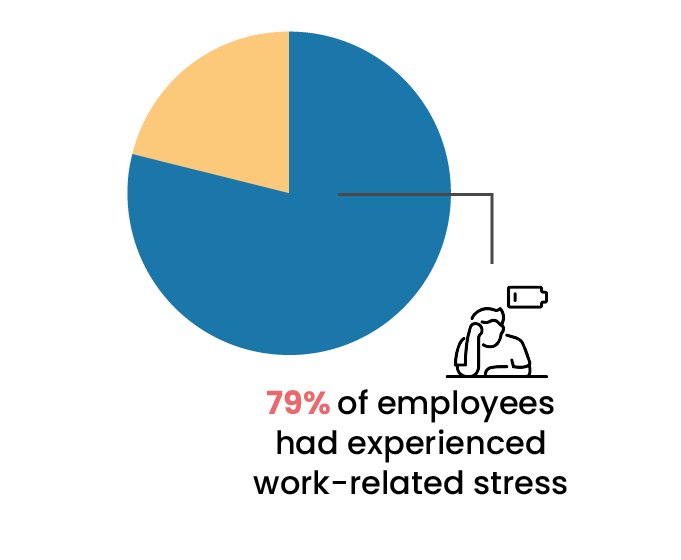How to Recover from Burnout: 11 Strategies To Reclaim Your Well-being
Going through stress can be a difficult time for anyone. But what do you do to cope?
People often have no choice but to quit in such circumstances. Yes, it's true. Stress in the workplace can lead to burnout, absenteeism, and unproductivity, among other things.
Moreover, burnout is not just a behavioural problem. It can also cause physical, emotional, and mental health issues. But even though burnout rates are booming, recovering from it is still possible.
Understanding The Problem

Burnout is the condition of total mental, physical, and emotional exhaustion. Burnout may make it difficult for you to engage in activities you once found meaningful. It may also become harder for you to care about things that matter to you, whether work or personal.
Burnout occurs slowly and gradually over time, robbing an employee's passion, motivation, and energy to work. It also leads to exhaustion, disillusionment, and frustration. When burned out, you might feel fatigued, cynical, and detached from reality.
According to a study by Asana, 70% of people experienced burnout in the last year (2022), which examined 10,000 knowledge workers across seven countries. Additionally, multiple generations suffer from burnout, with 84% of Generation Z, 74% of Millennials, and 47% of Baby Boomers reporting it.

The biggest question is whether burnout has become a "part of the job." According to a recent Gallup study, organizations are facing a burnout crisis. Nearly two-thirds of full-time workers experience burnout on the job. Burned-out employees are 63% more likely to take a sick day and 2.6 times as likely to seek a different job.
But, when there is a problem, there is a solution too. Recovering from burnout can be hassle-free if you learn and follow these 11 tips below.
11 Ways On How To Recover From Burnout Without Quitting Your Job

Burnout is an extreme form of chronic stress that can lead to physical, mental, and psychological exertion. Even though burnout isn't an officially recognized medical condition, you can help yourself recognize and recover from it.
1. Track, recognize, and acknowledge burnout:
Acknowledge and understand the signs and symptoms of burnout, such as chronic exhaustion, decreased productivity, and increased cynicism. Keep track and gather the recovery essentials for your well-being.
Recognize burnout symptoms before you're fully burned out. Because in the long run, the ultimate goal is to lead a balanced life with time for work, relationships, relaxation, and fun. Building resilience is vital to handle pressure and meet challenges head-on.
2. Personalized Retreat:
Allow yourself to take a break from work. Travel to a serene and inspiring location. Embark on an adventurous journey and immerse yourself in those breathtaking landscapes and unique cultures. Breathe in some freshness and rejuvenate your mind, body, and soul.
Leave behind the stress and any triggers that may lead to burnout. Reset, recharge, and engage in activities that bring joy and relaxation to start afresh.
3. Prioritize the self-care regime:
Putting yourself on top of your priority list is also self-awareness. So, indulge in daily self-care activities promoting physical, mental, and spiritual well-being. It can be yoga, morning workouts, 7-minute exercises, healthy eating, quality sleep, and practising mindfulness meditation.
Prioritizing self-care can boost productivity and morale. It will allow you to see the path to accomplishment, gain clarity, and set boundaries in your personal and professional life.
Listen to the podcast: The Workplace and Self-Care by Shweta Gautam
4. Say no when necessary:
How can one know exactly when to say no?
You must ask certain questions about the situation before saying yes. Can I concentrate on the other important things if I say yes? If I say yes, will I become even more tired or burned out?
To establish clear boundaries between work and personal life, learn to say no to excessive demands or responsibilities that can contribute to burnout. Saying no is also a way to value your needs and maintain balance.
5. Seek support and accountability:
Reach out to friends, family, or trusted colleagues to share your emotions and experiences. You can also consider talking to a therapist or counsellor who can provide guidance and support during your recovery.
Don't hesitate to delegate tasks or ask for assistance from co-workers in a quandary. Share the workload with others and seek opinions from colleagues or supervisors to prevent being overwhelmed.
6. Evaluate and reassess priorities:
Evaluating and reassessing help in understanding triggers and taking action. So reflect on your values, goals, and priorities. Identify areas of your life or work that are contributing to burnout and consider taking necessary actions to recover.
As circumstances change, be flexible and adapt to your boundaries accordingly to maintain a healthy work-life balance.
7. Stress management techniques:
Living with high levels of stress can put your entire well-being at risk. It narrows your ability to think clearly, function effectively, and enjoy life. Stress creates havoc in your emotional, physical, and mental equilibrium.
Therefore, incorporate stress management activities into your daily routine. This can include deep breathing exercises, journaling, calming music, or engaging in productive hobbies that help you relax.
Listen to: Integrating Breathwork As A Wellness Strategy At The Workplace by Ed Harrold
8. Engage in activities you enjoy:
Make time to enjoy activities that can elevate your happiness level. These can even be dining in your favourite restaurant, shopping, or booking an appointment in a luxurious spa.
You can also spend time in outdoors activities to restore your energy and enthusiasm. Ensure you take time to engage in recreational activities and keep burnout at bay.
9. Focus on positive relationships:
Heaphy and Dutton (2008) state that "positive social interactions bolster physiological resourcefulness by fortifying the cardiovascular, immune, and neuroendocrine systems through immediate and enduring decreases in cardiovascular reactivity, strengthened immune responses, and healthier hormonal patterns."
Nurture and prioritize positive relationships in your personal and professional life. Surround yourself with supportive and uplifting individuals who can provide encouragement and understanding. Positive relationships at work directly affect your entire physiological processes.
10. Gradually reintroduce work responsibilities:
Covid-19 has taught us much about working from home or returning to work after 2 years. Hence, it won't be difficult to reshuffle your schedule for good.
When you feel ready to return to work or resume regular activities, do so gradually. To avoid overstressing yourself, start with manageable tasks and gradually increase your workload. This will help you avoid burnout and be at ease.
11. Give your desk a makeover:
Giving your desk a makeover can bring a fresh perspective to the table and your life. Invest in ergonomic furniture and use inspiring décor to foster a more comfortable and motivating environment.
You spend one-third of your time in and around the office. So, why not make it more amicable and voguish to fight burnout?
Read: Workplace Ergonomics: Benefits And Ways To Improve It
How Can Employers Help Employees Recover From Burnout?

As in 2020, American workers across the board saw heightened rates of burnout in 2021, and according to APA’s 2021 Work and Well-being Survey of 1,501 U.S. adult workers, 79% of employees had experienced work-related stress in the month before the survey.

Employers should adopt a contemporary approach based on their employees' organizational needs and well-being. Here are five key points that employers might want to look into:
1. Fostering a supportive environment:
Employers can create a workplace culture that values and supports employee well-being. They can encourage open communication, provide stress management resources, and ensure employees feel comfortable seeking help when needed.
2. Facilitating standard time off:
Promoting the importance of taking regular breaks and vacations is vital. For employees to disconnect and then reconnect is more needed now than ever.
3. Reconsidering workload and expectations:
Assessing employee workloads and ensuring they are manageable is the first thing employers can do. Excessive overtime and unrealistic deadlines can cause burnout.
Employers must communicate with employees to set realistic expectations and adjust their workload.
4. Focusing on overall wellness:
Health and wellness are pivotal to organizational growth and success. Providing employees with the right corporate wellness plan, counselling services, or workshops can assist them in leading a healthy lifestyle.
Mental, emotional, physical, and spiritual health awareness reduces workplace stigma.
5. Offering learning and development opportunities:
Providing employees with learning and training opportunities to develop skills can enhance job satisfaction and retention. This will help employees feel more engaged and motivated toward achieving their future goals.
Thus, a win-win for both parties (employer and employee).
Bottom Line

According to researchers at the German universities of Zürich and Leipzig, people's implicit motives, or their unconscious needs, play an important part in developing burnout.
Burnout recovery isn't a one-day process; for some, it might take up to 2 years. No matter what, be kind to yourself, and do what you can to recover. In this case, your best is all that matters. Making a big difference takes just a few small actions each day.
Frequently Asked Questions

1. What is Burnout?
Burnout is a state of chronic physical and emotional exhaustion that occurs when individuals fail to meet or align their personal and professional lives. Stress often triggers it, creating a lack of motivation and emotional burnout at work.
The American Psychological Association (APA) links burnout to mental health issues like anxiety, depression, and substance abuse.
2. What are common signs of employee burnout?
Exhaustion, decreased performance, emotional detachment, increased irritability, and physical symptoms.
3. How can employees recover from burnout?
Take time off, set boundaries, prioritize self-care, seek support, and reassess workload.
4. What are the long-term effects of untreated burnout on employees?
Untreated burnout can lead to chronic physical and mental health problems, decreased job satisfaction, strained relationships, and reduced productivity and performance.
5. How can organizations proactively prevent employee burnout?
There are several policies and practices that organizations can adopt to promote work-life balance. They can provide support programs for employees, encourage open communication, offer stress management and resilience training, and adjust workloads and expectations regularly.



